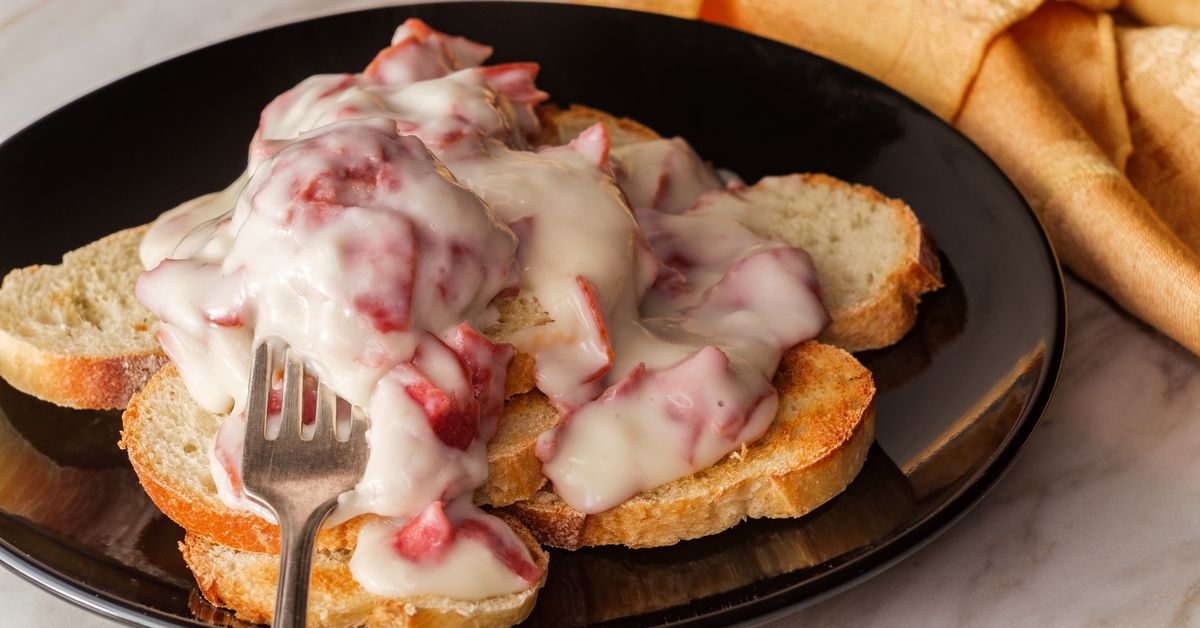
On busy nights when I was growing up, it was not uncommon to watch my mom brown a pound of ground beef on the stove, then add flour, milk, Cajun seasoning, and cream of mushroom soup to create a pasty gloop to be eaten over slices of toasted sandwich bread. There’s nothing inherently wrong with these ingredients — ground beef and cream of mushroom soup are perfectly fine together — but because my parents gleefully referred to the beige-colored slop as “shit on a shingle,” it was always clear that this was a dinner of last resort.
Of course, my family did not invent shit on a shingle, also called S.O.S — the U.S. Army did. The first official recipe for “creamed chipped beef” appeared in a 1910 Army cooking manual, and later, during World War II, it earned its less-than-appetizing moniker. No one knows who exactly gave S.O.S. its decidedly distinctive name, but the soldiers who were involved unwittingly joined a rich tradition in both the United States and beyond of giving names to foods that are humorously descriptive, charmingly folksy, or jarringly off-kilter.
Devils on Horseback, a recent cookbook from Australian food collective Long Prawn, takes a global look at some of the planet’s unexpectedly named dishes, many of which have origins that are decades (or centuries) old. Its most compelling recipe is the story of pets-de-nonne, a fried, cream-filled French doughnut whose name means “nun’s farts.” One theory presented in the book holds that the pastry was invented at the Abbey of Marmoutier in Tours, France, as its nuns prepared a feast for the city’s Archbishop. Amidst the chaos, a nun named Agnes allegedly let out a fart so startling that she dropped a spoonful of prepared choux pastry into a vat of hot oil, and the rest is history.
But not everyone is on board with this arguably offensive, fart-inspired origin story. In Spain, the pastries are called suspiros de monja, or “the nun’s sigh,” which certainly sounds more appropriate for a church setting. “Vincent La Chapelle, in his book The Modern Cook, excommunicates from religious associations entirely and refers to the flatulent doughnut as Pets-de-Putain, or ‘Whore’s Farts,’” reads Devils on Horseback. “Then there is the most holy claim of all, that ‘pets’ is a mistaken inscription of ‘paix,’ meaning peace.”
In the United States, community cookbooks, or cookbooks created by groups like churches and women’s auxiliary clubs, are a wealth of absurd food names. One of the best known is Johnny Marzetti, a pasta casserole with tomato sauce and cheese that’s famous throughout the Midwest. According to the Kitchn, the dish was invented in 1896 by Teresa Marzetti, the sister-in-law of a Columbus, Ohio restaurateur named — you guessed it — Johnny. The comforting dish was a staple for Ohio State University students and was served at Marzetti’s restaurants until the early 1970s. By then, home cooks across the country had created their own versions with their own names: Some regions call it American chop suey, or even American goulash, despite pretty minimal resemblance to Hungarian meat stew. In parts of the South, it’s called “slumgullion,” a word that roughly translates to “cheap, inferior stew” while lending a mysterious, slightly seedy air to a dish that is common on dinner tables.
There’s an element of trickery in a dish with a funny name, one that is both disarming and enticing. “Devils on horseback” sounds a whole lot fancier and more compelling than “slice of bacon wrapped around a prune,” and it’s the kind of name that can spark a conversation. A more pejorative name like “shit on a shingle” functions similarly — here, the exaggeration is effacing instead of aggrandizing, and it’s funny while still clearly communicating that chipped beef on toast isn’t exactly fine dining.
The past several decades have brought a real dearth of creative, funny food names. (To be clear, mashups like “cronut” don’t count.) On restaurant menus, dishes are often reduced to their components — a protein, sides, and accouterments — which is both good and bad. It’s nice to know exactly what’s in the bowl of risotto you’re about to consume, but there’s no mystery or whimsy in a dish that’s simply described as beef short rib, mashed potatoes, and jus. That trend has also made its way to the realm of home cooking, where straightforwardly named dishes like Alison Roman’s “The Stew” reign supreme. And while there may be home cooks coming up with inventive names for the dishes they create, our TikTok feeds are flooded with people trying to out-weird each other with over-the-top (and gross) creations or yawn-inducing fads like “healthy Coke.”
Perhaps the most recent, evocatively named food to achieve widespread notoriety came in the 1980s, when chef Jean-Georges Vongerichten claimed credit for inventing the molten chocolate lava cake. The pool of dark chocolate ganache that spills forth from a stumpy little chocolate cake is compelling enough on its own, but comparing it to lava? That added a whole new level of intrigue.
Fun names make food more fun; it’s as simple as that. I’ve been trying it myself at home. For example, my version of a Philly cheesesteak, made with shaved ribeye and provolone, is cheekily called a fuck Philly, because I want to be clear about the inspiration while also paying appropriate homage to the home of the Eagles. The same goes for my beloved garbage soup, which involves simply rounding up all the nearly limp vegetables in my fridge, roasting them, and pureeing until I’ve got a soup. These names are not especially creative, but I’m trying, and I’d love to see a new crop of chefs — and home cooks — invent the next shit on a shingle.
